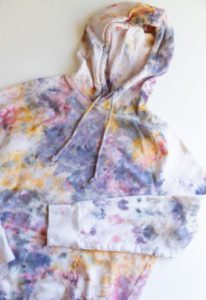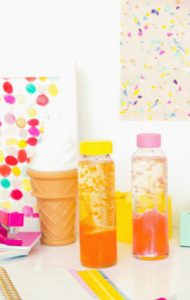“I’m bored.” – three words that can change everything for parents at the moment. Well, we have a solution to this biggest problem. We have found 3 amazing and productive DIY activities to keep your munchkins busy.
Read on!
1) Ice Dye Hoodie

You’ve done tie-dying, now see what happens when you ice-dye your hoodies and tote bags. A project best attempted with older ones, ice-dying involves pre-treating fabric, then putting powdered dye on top of the ice, which makes cool patterns when it melts.
Supplies:
- White Adult T-Shirt, 2-Pack
- One-Step Tie-Dye Kit
- White Vinegar
- Plastic Rectangular Tablecloth, 2-Pack
- Reusable Rubber Gloves
- Dowel Rods
- Rubber Bands
- Gallon Food Storage Bags
How to:
- Prepare your workspace: Cover your work surface with a plastic tablecloth, old sheet, or garbage bag to protect it from any spills and stains. While it’s best to tie-dye outside, you can get the job done in your tub or shower.
- Get the dye ready: Follow the instructions on the tie-dye kit’s packaging for the best results. For a homemade dye option, fill a squeeze bottle with water and add 8 drops of food coloring.
- Increase the dye’s staying power: Lay a shirt (or whatever else you’re dyeing) flat in a large plastic bowl and cover with ½ cup of white vinegar and ½ cup water mixture. Let it sit for 30 minutes.
- Pick your design: After the full soaking time has passed, wring out the shirt and lay it flat, with the front of the shirt facing up. For a classic spiral design, place your finger or dowel rod in the center of the shirt and start turning clockwise until the entire shirt reaches a spiral design. Remove the dowel or finger from the center. For a crumpled design, simply crumple the item with your fingers. For a striped design, accordion pleat and fold fabric either vertically or horizontally.
- Secure the shape: Place rubber bands horizontally, vertically, and diagonally around the shirt.
- Start dyeing: Wearing rubber gloves, dye sections with your chosen colors. Keep it as precise as you’d like. Just make sure you dye with light colors first (yellow, for example), so you don’t cover it up by mistake.
- Flip it over: When you finish dyeing one side, turn the shirt over and repeat the same process on the back.
- Let it sit: Place the completed item in a plastic bag and seal shut. Let it sit for at least 8 hours — the less time it rests, the lighter the dye will be. However, waiting for 24 to 36 hours will give you the most vibrant results.
- Remove excess dye: Wearing rubber gloves, remove the item from the bag and stick it in the washer on a regular cycle with detergent. Then tumble dry.
Source: https://www.goodhousekeeping.com/clothing/a32802945/how-to-tie-dye/
2) Rainbow Walking Water

Supplies:
- Printable walking water recording sheets (button to download at the bottom of the post)
- Small plastic cups or glasses
- Paper towels (*read my tips below for picking the right ones)
- Food coloring in primary colors
- Water
How to:
The pick-a-size paper towels are best because then you just use half sheets for each cup. If you only have full sheets, then cut them in half. I’ve also heard that more absorbent paper towels work better too. I buy the cheap store brand ones, and our water moved pretty quickly from cup to cup, so I am not sure how important that is. It may have gone quicker with something more absorbent though.
1. Print out the recording sheets and make copies, if needed.
2. Place 7 cups in a row and pour water in the 1st, 3rd, 5th, and 7th cups. My cups were about 3/4 full. I have since heard that fuller is better.
3. Add 5 drops of red food coloring to the 1st cup and the 7th cup.
4. Add 5 drops of yellow food coloring to the 3rd cup.
5. Add 5 drops of blue food coloring to the 5th cup.
6. Take a half sheet of paper towel and fold it in half lengthwise and in half again lengthwise.
7. Trim off some of the lengths so that there isn’t too much excess paper towel that will stick up in the air between each cup. This will make the water walk more quickly.
8. Place one half of a rolled paper towel in the 1st cup and place the other half in the cup next to it. Then another paper towel from the 2nd cup and into the 3rd cup. This continues until you have placed the last paper towel that drapes over from the 6th cup to the 7th cup.
9. Stare at the cups and watch what starts happening. You should quickly be able to see the colored water begin to crawl up the paper towel.
10. Don’t forget to do the first part of the recording sheet. Students will predict what they think will happen.
Source: https://funlearningforkids.com/rainbow-walking-water-science-experiment-kids/
3) DIY Lava Lamp

Lava lamps are back that to in a groovy new way.
Supplies:
Glass bottle
Vegetable oil
Liquid food coloring
Water
Alka seltzer tablets
Waterproof tea lights
How to:
- Put a small amount of water in a bowl and color it with liquid food coloring. Set aside.
- Fill your glass bottle 3/4 of the way with vegetable shortening. Pour the colored water into the bottle, leaving a little bit of room empty at the top. Allow the water to settle at the bottom of the glass.
- Drop your tea light into the bottom of the glass.
- Break up an Alka seltzer tablet into small pieces and place them one at a time into the bottle. Close the lid and watch the magic happen!
(Note: this reaction does only last a few minutes, but you can keep putting more Alka seltzer in time and time again to continue the reaction.)
Source: http://www.awwsam.com/2016/08/diy-lava-lamps-for-your-dorm-room.html

